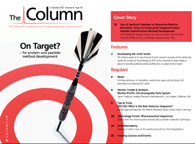Basic instinct
Spodoptera littoralis is a destructive caterpillar pest indigenous to tropical and subtropical areas of agriculture that has the potential, if accidentally imported, of becoming a major greenhouse pest in Northern Europe. The UK government agency Defra reports that many populations of the species are already highly pesticide resistant2.
Spodoptera littoralis is a destructive caterpillar pest indigenous to tropical and subtropical areas of agriculture that has the potential, if accidentally imported, of becoming a major greenhouse pest in Northern Europe. The UK government agency Defra reports that many populations of the species are already highly pesticide resistant2.
S. littoralis possess a pair of antennae for sensory perception, that vary in morphology between the larval and adult stages of development. Up until now, it was thought that on maturation, only adult males expressed specific protein receptors for the detection of female sex pheromones.Scientists at the Insect Physiology: Signalling and Communication research unit in Versailles, France 1, have identified that S. littoralis respond to the treatment of food sources with adult sex pheromone, providing an unexpected cue for food detection in S. littoralis larvae.
Gas chromatography–mass spectrometry (GC–MS) was utilized to extract the key component of S. littoralis pheromones from two-day old (adult) S. littoralis. Choice tests demonstrated that the larvae have an undefined mechanism of sensing adult pheromone that acts as a cue for food detection.
“Since the caterpillar behaviour we evidenced was totally unexpected, we had to use a combination of different approaches to be sure of it,” commented Dr Jacquin-Joly, leader of the team. “Gas chromatography coupled to mass spectrometry represents an invaluable tool to identify and quantify key odorant components in a natural extract.”
1. Emmanuelle Jacquin-Joly et al, Nature Comm. 3:1047 (2012).
2. Defra. “African Cotton Leafworm, Spodoptera littoralis: Fact-sheet”, (www. secure.fera.defra.gov.uk- Accessed September 2012).
This story originally appeared in The Column. Click here to view that issue.

Polysorbate Quantification and Degradation Analysis via LC and Charged Aerosol Detection
April 9th 2025Scientists from ThermoFisher Scientific published a review article in the Journal of Chromatography A that provided an overview of HPLC analysis using charged aerosol detection can help with polysorbate quantification.









